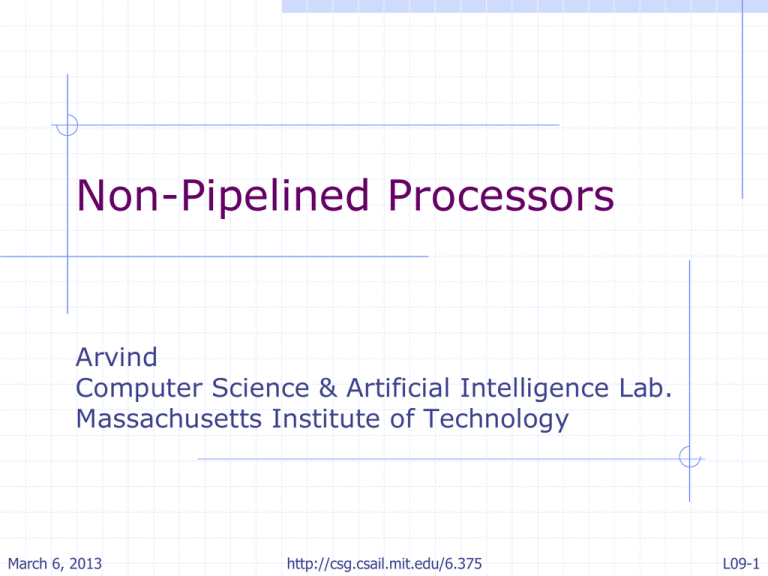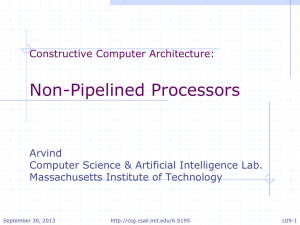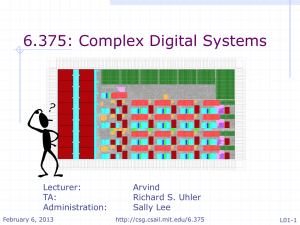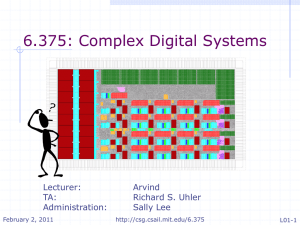L09-NonPipelinedProcessors
advertisement

Non-Pipelined Processors
Arvind
Computer Science & Artificial Intelligence Lab.
Massachusetts Institute of Technology
March 6, 2013
http://csg.csail.mit.edu/6.375
L09-1
Single-Cycle RISC Processor
As an illustrative example,
we will use SMIPS, a 35instruction subset of MIPS
ISA without the delay slot
PC
+4
Inst
Memory
Register File
Decode
2 read &
1 write
ports
Execute
separate
Instruction &
Data memories
Data
Memory
Datapath and control are derived automatically
from a high-level rule-based description
March 6, 2013
http://csg.csail.mit.edu/6.375
L09-2
Single-Cycle Implementation
code structure
module mkProc(Proc);
to be explained later
Reg#(Addr) pc <- mkRegU;
RFile
rf <- mkRFile;
instantiate the state
IMemory
iMem <- mkIMemory;
DMemory
dMem <- mkDMemory;
rule doProc;
let inst = iMem.req(pc);
extracts fields
let dInst = decode(inst);
needed for
let rVal1 = rf.rd1(dInst.rSrc1); execution
let rVal2 = rf.rd2(dInst.rSrc2);
let eInst = exec(dInst, rVal1, rVal2, pc);
produces values
update rf, pc and dMem
needed to
update the
processor state
http://csg.csail.mit.edu/6.375
March 6, 2013
L09-3
SMIPS Instruction formats
6
opcode
6
opcode
6
opcode
5
5
rs
rt
5
5
rs
5
rd
5
shamt
6
func
16
rt
immediate
26
target
R-type
I-type
J-type
Only three formats but the fields are used
differently by different types of instructions
March 6, 2013
http://csg.csail.mit.edu/6.375
L09-4
Instruction formats
cont
Computational Instructions
6
0
opcode
5
5
rs
rt
rs
rt
5
rd
5
0
6
func
rd (rs) func (rt)
immediate
rt (rs) op immediate
Load/Store Instructions
6
opcode
31
26 25
5
5
rs
16
rt
21 20
addressing mode
displacement
16 15
(rs) + displacement
0
rs is the base register
rt is the destination of a Load or the source for a Store
March 6, 2013
http://csg.csail.mit.edu/6.375
L09-5
Control Instructions
Conditional (on GPR) PC-relative branch
6
opcode
5
rs
5
16
offset
BEQZ, BNEZ
target address = (offset in words)4 + (PC+4)
range: 128 KB range
Unconditional register-indirect jumps
6
opcode
5
rs
5
16
JR, JALR
Unconditional absolute jumps
6
opcode
26
target
J, JAL
target address = {PC<31:28>, target4}
range : 256 MB range
jump-&-link stores PC+4 into the link register (R31)
March 6, 2013
http://csg.csail.mit.edu/6.375
L09-6
Decoding Instructions:
extract fields needed for execution
31:26, 5:0
iType
IType
31:26
aluFunc
AluFunc
5:0
instruction
Bit#(32)
pure combinational
logic: derived
automatically from
the high-level
description
31:26
20:16
15:11
25:21
20:16
15:0
25:0
March 6, 2013
brComp
BrFunc
ext
http://csg.csail.mit.edu/6.375
Type DecodedInst
decode
rDst
Maybe#(RIndx)
rSrc1
Maybe#(RIndx)
rSrc2
Maybe#(RIndx)
imm
Maybe#(Bit#(32))
L09-7
Decoded Instruction
typedef struct {
IType
iType;
AluFunc
aluFunc;
BrFunc
brFunc;
Maybe#(FullIndx) dst;
Maybe#(FullIndx) src1;
Maybe#(FullIndx) src2;
Maybe#(Data)
imm;
} DecodedInst deriving(Bits, Eq);
Destination
register 0 behaves
like an Invalid
destination
Instruction groups
with similar
executions paths
typedef enum {Unsupported, Alu, Ld, St, J, Jr, Br}
IType deriving(Bits, Eq);
typedef enum {Add, Sub, And, Or, Xor, Nor, Slt, Sltu,
LShift, RShift, Sra} AluFunc deriving(Bits, Eq);
typedef enum {Eq, Neq, Le, Lt, Ge, Gt, AT, NT} BrFunc
deriving(Bits, Eq);
FullIndx is similar to RIndx; to be explained later
March 6, 2013
http://csg.csail.mit.edu/6.375
L09-8
Decode Function
function DecodedInst decode(Bit#(32) inst);
DecodedInst dInst = ?;
initially
let opcode = inst[ 31 : 26 ];
undefined
let rs
= inst[ 25 : 21 ];
let rt
= inst[ 20 : 16 ];
let rd
= inst[ 15 : 11 ];
let funct = inst[ 5 : 0 ];
let imm
= inst[ 15 : 0 ];
let target = inst[ 25 : 0 ];
case (opcode)
...
6
5
5
5
5
6
opcode rs
rt
rd shamt func
endcase
opcode
rs
rt
immediate
return dInst;
opcode
target
endfunction
March 6, 2013
http://csg.csail.mit.edu/6.375
L09-9
Naming the opcodes
Bit#(6)
Bit#(6)
Bit#(6)
Bit#(6)
Bit#(6)
Bit#(6)
…
Bit#(6)
Bit#(6)
Bit#(6)
Bit#(6)
…
Bit#(6)
Bit#(6)
Bit#(6)
March 6, 2013
opADDIU
opSLTI
opLW
opSW
opJ
opBEQ
=
=
=
=
=
=
6’b001001;
6’b001010;
6’b100011;
6’b101011;
6’b000010;
6’b000100;
opFUNC
fcADDU
fcAND
fcJR
=
=
=
=
6’b000000;
6’b100001;
6’b100100;
6’b001000;
opRT
rtBLTZ
rtBGEZ
= 6’b000001;
= 5’b00000;
= 5’b00100;
bit patterns are specified
in the SMIPS ISA
http://csg.csail.mit.edu/6.375
L09-10
Instruction Groupings
instructions with common execution steps
case (opcode)
opADDIU, opSLTI, opSLTIU, opANDI, opORI, opXORI, opLUI: …
opLW: …
opSW: …
opJ, opJAL: …
These
opBEQ, opBNE, opBLEZ, opBGTZ, opRT: …
groupings
opFUNC: case (funct)
are
fcJR, fcJALR: …
somewhat
fcSLL, fcSRL, fcSRA: …
arbitrary
fcSLLV, fcSRLV, fcSRAV: …
fcADDU, fcSUBU, fcAND, fcOR, fcXOR,
fcNOR, fcSLT, fcSLTU: … ;
default: // Unsupported
endcase
default: // Unsupported
endcase;
March 6, 2013
http://csg.csail.mit.edu/6.375
L09-11
Decoding Instructions:
I-Type ALU
opADDIU, opSLTI, opSLTIU, opANDI, opORI, opXORI, opLUI:
begin
dInst.iType
= Alu;
dInst.aluFunc = case (opcode)
dInst.dst
dInst.src1
dInst.src2
dInst.imm
=
=
=
=
opADDIU,
opLUI:
opADDIU, opLUI: Add;
opSLTI: Slt;
opSLTIU: Sltu;
opANDI: And;
opORI: Or;
opXORI: Xor;
endcase;
almost like writing
validReg(rt);
(Valid rt)
validReg(rs);
Invalid;
Valid (case(opcode)
opSLTI, opSLTIU: signExtend(imm);
{imm, 16'b0};
endcase);
dInst.brFunc = NT;
end
March 6, 2013
http://csg.csail.mit.edu/6.375
L09-12
Decoding Instructions:
Load & Store
opLW: begin
dInst.iType
dInst.aluFunc
dInst.rDst
dInst.rSrc1
dInst.rSrc2
dInst.imm
dInst.brFunc
opSW: begin
dInst.iType
dInst.aluFunc
dInst.rDst
dInst.rSrc1
dInst.rSrc2
dInst.imm
dInst.brFunc
March 6, 2013
=
=
=
=
=
=
=
Ld;
Add;
validReg(rt);
validReg(rs);
Invalid;
Valid (signExtend(imm));
NT;
end
=
=
=
=
=
=
=
St;
Add;
Invalid;
validReg(rs);
validReg(rt);
Valid(signExtend(imm));
NT;
end
http://csg.csail.mit.edu/6.375
L09-13
Decoding Instructions:
Jump
opJ, opJAL:
begin
dInst.iType
dInst.rDst
= J;
= opcode==opJ ? Invalid :
validReg(31);
dInst.rSrc1 = Invalid;
dInst.rSrc2 = Invalid;
dInst.imm
= Valid(zeroExtend(
{target, 2’b00}));
dInst.brFunc = AT;
end
March 6, 2013
http://csg.csail.mit.edu/6.375
L09-14
Decoding Instructions:
Branch
opBEQ, opBNE, opBLEZ, opBGTZ, opRT:
begin
dInst.iType = Br;
dInst.brFunc = case(opcode)
opBEQ: Eq;
opBNE: Neq;
opBLEZ: Le;
opBGTZ: Gt;
opRT: (rt==rtBLTZ ? Lt : Ge);
endcase;
dInst.dst
= Invalid;
dInst.src1
= validReg(rs);
dInst.src2
= (opcode==opBEQ||opcode==opBNE)?
validReg(rt) : Invalid;
dInst.imm
= Valid(signExtend(imm) << 2);
end
March 6, 2013
http://csg.csail.mit.edu/6.375
L09-15
Decoding Instructions:
opFUNC, JR
opFUNC:
case (funct)
fcJR, fcJALR:
begin
dInst.iType
dInst.dst
= Jr;
= funct == fcJR? Invalid:
validReg(rd);
dInst.src1
= validReg(rs);
dInst.src2
= Invalid;
dInst.imm
= Invalid;
dInst.brFunc = AT;
JALR stores the pc in rd as
end
opposed to JAL which
stores the pc in R31
fcSLL, fcSRL, fcSRA: …
March 6, 2013
http://csg.csail.mit.edu/6.375
L09-16
Decoding Instructions:
opFUNC- ALU ops
fcADDU, fcSUBU, fcAND, fcOR, fcXOR, fcNOR, fcSLT, fcSLTU:
begin
dInst.iType
= Alu;
dInst.aluFunc = case (funct)
fcADDU: Add;
fcSUBU: Sub;
fcAND : And;
fcOR : Or;
fcXOR : Xor;
fcNOR : Nor;
fcSLT : Slt;
fcSLTU: Sltu; endcase;
dInst.dst
= validReg(rd);
dInst.src1
= validReg(rs);
dInst.src2
= validReg(rt);
dInst.imm
= Invalid;
dInst.brFunc = NT
end
default: // Unsupported
endcase
March 6, 2013
http://csg.csail.mit.edu/6.375
L09-17
Decoding Instructions:
Unsupported instruction
default:
begin
dInst.iType
dInst.dst
dInst.src1
dInst.src2
dInst.imm
dInst.brFunc
end
endcase
March 6, 2013
=
=
=
=
=
=
Unsupported;
Invalid;
Invalid;
Invalid;
Invalid;
NT;
http://csg.csail.mit.edu/6.375
L09-18
Reading Registers
Read registers
RSrc1
RSrc2
RF
RVal1
RVal2
Pure
combinational
logic
March 6, 2013
http://csg.csail.mit.edu/6.375
L09-19
Executing Instructions
execute
iType
dst
dInst
rVal2
data
ALU
rVal1
ALUBr
Pure
combinational
logic
pc
March 6, 2013
Branch
Address
http://csg.csail.mit.edu/6.375
either for
rf write or
St
either for
memory
addr reference
or branch
target
brTaken
missPredict
L09-20
Output of exec function
typedef struct {
IType
iType;
Maybe#(FullIndx) dst;
Data
data;
Addr
addr;
Bool
mispredict;
Bool
brTaken;
} ExecInst deriving(Bits, Eq);
March 6, 2013
http://csg.csail.mit.edu/6.375
L09-21
Execute Function
function ExecInst exec(DecodedInst dInst, Data rVal1,
Data rVal2, Addr pc);
ExecInst eInst = ?;
Data aluVal2
= fromMaybe(rVal2, dInst.imm);
let aluRes
eInst.iType
eInst.data
let brTaken
let brAddr
eInst.brTaken
eInst.addr
eInst.dst
return eInst;
endfunction
March 6, 2013
= alu(rVal1, aluVal2, dInst.aluFunc);
= dInst.iType;
= dInst.iType==St? rVal2 :
(dInst.iType==J || dInst.iType==Jr)?
(pc+4) : aluRes;
= aluBr(rVal1, rVal2, dInst.brFunc);
= brAddrCalc(pc, rVal1, dInst.iType,
fromMaybe(?, dInst.imm), brTaken);
= brTaken;
= (dInst.iType==Ld || dInst.iType==St)?
aluRes : brAddr;
= dInst.dst;
http://csg.csail.mit.edu/6.375
L09-22
Branch Address Calculation
function Addr brAddrCalc(Addr pc, Data val,
IType iType, Data imm, Bool taken);
Addr pcPlus4 = pc + 4;
Addr targetAddr = case (iType)
J : {pcPlus4[31:28], imm[27:0]};
Jr : val;
Br : (taken? pcPlus4 + imm : pcPlus4);
Alu, Ld, St, Unsupported: pcPlus4;
endcase;
return targetAddr;
endfunction
March 6, 2013
http://csg.csail.mit.edu/6.375
L09-23
Single-Cycle SMIPS
atomic state
updates
if(eInst.iType == Ld)
eInst.data <- dMem.req(MemReq{op: Ld,
addr: eInst.addr, data: ?});
else if (eInst.iType == St)
let dummy <- dMem.req(MemReq{op: St,
addr: eInst.addr, data: data});
if(isValid(eInst.dst))
rf.wr(validRegValue(eInst.dst), eInst.data);
pc <= eInst.brTaken ? eInst.addr : pc + 4;
endrule
endmodule
March 6, 2013
state updates
The whole processor is described using one rule;
lots of big combinational functions
http://csg.csail.mit.edu/6.375
L09-24
Harvard-Style Datapath
for MIPS
PCSrc
br
rind
jabs
pc+4
RegWrite
old way
MemWrite
WBSrc
0x4
Add
Add
clk
PC
clk
addr
inst
31
Inst.
Memory
we
rs1
rs2
rd1
ws
wd rd2
clk
we
addr
ALU
GPRs
z
rdata
Data
Memory
Imm
Ext
wdata
ALU
Control
OpCode RegDst
March 6, 2013
ExtSel
OpSel
BSrc
http://csg.csail.mit.edu/6.375
zero?
L09-25
old way
Hardwired Control Table
Opcode
ALU
ExtSel
BSrc
OpSel
MemW
RegW
WBSrc
RegDst
PCSrc
SW
*
sExt16
uExt16
sExt16
sExt16
Reg
Imm
Imm
Imm
Imm
Func
Op
Op
+
+
no
no
no
no
yes
yes
yes
yes
yes
no
ALU
ALU
ALU
Mem
*
rd
rt
rt
rt
*
pc+4
pc+4
pc+4
pc+4
pc+4
BEQZz=0
sExt16
*
0?
no
no
*
*
br
BEQZz=1
sExt16
*
*
*
*
*
no
no
no
no
no
*
*
*
*
pc+4
jabs
*
*
*
*
0?
*
*
*
*
yes
no
yes
PC
*
PC
R31
*
R31
jabs
rind
rind
ALUi
ALUiu
LW
J
JAL
JR
JALR
BSrc = Reg / Imm
RegDst = rt / rd / R31
March 6, 2013
no
no
WBSrc = ALU / Mem / PC
PCSrc = pc+4 / br / rind / jabs
http://csg.csail.mit.edu/6.375
L09-26
Single-Cycle SMIPS:
Clock Speed
Register File
PC
+4
Decode
Execute
Inst
Memory
Data
Memory
tClock > tM + tDEC + tRF + tALU+ tM+ tWB
We can improve the clock speed if we execute each
instruction in two clock cycles
tClock > max {tM , (tDEC + tRF + tALU+ tM+ tWB )}
However, this may not improve the performance because
each instruction will now take two cycles to execute
March 6, 2013
http://csg.csail.mit.edu/6.375
L09-27
Structural Hazards
Sometimes multicycle implementations are
necessary because of resource conflicts, aka,
structural hazards
Princeton style architectures use the same memory
for instruction and data and consequently, require at
least two cycles to execute Load/Store instructions
If the register file supported less than 2 reads and
one write concurrently then most instructions would
take more than one cycle to execute
Usually extra registers are required to hold
values between cycles
March 6, 2013
http://csg.csail.mit.edu/6.375
L09-28
Two-Cycle SMIPS
Register File
state
PC
+4
f2d
Decode
Execute
Data
Memory
Inst
Memory
Introduce register “f2d” to hold a fetched
instruction and register “state” to remember the
state (fetch/execute) of the processor
March 6, 2013
http://csg.csail.mit.edu/6.375
L09-29
Two-Cycle SMIPS
module mkProc(Proc);
Reg#(Addr) pc <- mkRegU;
RFile
rf <- mkRFile;
IMemory
iMem <- mkIMemory;
DMemory
dMem <- mkDMemory;
Reg#(Data) f2d <- mkRegU;
Reg#(State) state <- mkReg(Fetch);
rule doFetch (state == Fetch);
let inst = iMem.req(pc);
f2d <= inst;
state <= Execute;
endrule
March 6, 2013
http://csg.csail.mit.edu/6.375
L09-30
Two-Cycle SMIPS
rule doExecute(stage==Execute);
let inst = f2d;
let dInst = decode(inst);
let rVal1 = rf.rd1(validRegValue(dInst.src1));
let rVal2 = rf.rd2(validRegValue(dInst.src2));
let eInst = exec(dInst, rVal1, rVal2, pc);
if(eInst.iType == Ld)
eInst.data <- dMem.req(MemReq{op: Ld, addr:
eInst.addr, data: ?});
else if(eInst.iType == St)
let d <- dMem.req(MemReq{op: St, addr:
eInst.addr, data: eInst.data});
if (isValid(eInst.dst))
rf.wr(validRegValue(eInst.dst), eInst.data);
pc <= eInst.brTaken ? eInst.addr : pc + 4;
stage <= Fetch;
no change from single-cycle
endrule endmodule
March 6, 2013
http://csg.csail.mit.edu/6.375
L09-31
Two-Cycle SMIPS:
Fetch
Analysis
Execute
Register File
stage
PC
+4
f2d
Decode
Execute
Data
Memory
Inst
Memory
In any given clock cycle, lots of unused hardware!
next lecture: Pipelining to increase the throughput
March 6, 2013
http://csg.csail.mit.edu/6.375
L09-32
Coprocessor Registers
MIPS allows extra sets of 32-registers each to support
system calls, floating point, debugging etc. These
registers are known as coprocessor registers
The registers in the nth set are written and read using
instructions MTCn and MFCn, respectively
Set 0 is used to get the results of program execution
(Pass/Fail), the number of instructions executed and the
cycle counts
Type FullIndx is used to refer to the normal registers plus
the coprocessor set 0 registers
function validRegValue(FullIndx r) returns index of r
typedef Bit#(5) RIndx;
typedef enum {Normal, CopReg} RegType deriving (Bits, Eq);
typedef struct {RegType regType; RIndx idx;} FullIndx;
deriving (Bits, Eq);
March 6, 2013
http://csg.csail.mit.edu/6.375
L09-33
Processor interface
interface Proc;
method Action hostToCpu(Addr startpc);
method ActionValue#(Tuple2#(RIndx, Data)) cpuToHost;
endinterface
refers to coprocessor registers
March 6, 2013
http://csg.csail.mit.edu/6.375
L09-34
Code with coprocessor
calls
let copVal = cop.rd(validRegValue(dInst.src1));
let eInst = exec(dInst, rVal1, rVal2, pc, copVal);
pass coprocessor register values to execute MFC0
cop.wr(eInst.dst, eInst.data);
write coprocessor registers (MTC0) and indicate
the completion of an instruction
We did not show these lines in our processor to
avoid cluttering the slides
March 6, 2013
http://csg.csail.mit.edu/6.375
L09-35








